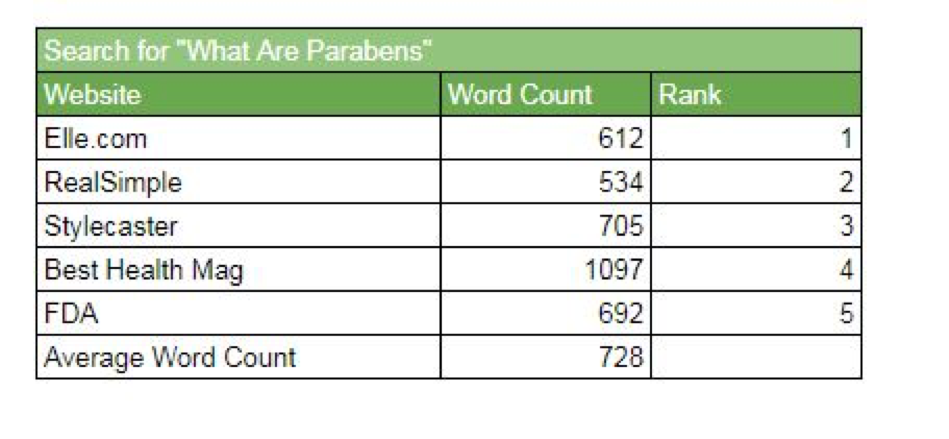
SEO can bring enormous benefit to brands, but it can be a bit confusing and lead to a lot of conflicting “facts” floating around. Here, we’ve laid out a few major SEO “myths” along with some options to pivot to instead.
Myth #1: Keyword Density Matters
Keyword density refers to the number of times a given page mentions a certain word. In the past, SEO specialists would try to hit a certain percentage (usually around 3%) of keyword density on everything they produced. In reality, Google only needs to see the “target” keyword a few times to understand the page material.
What to Do Instead:
Instead of using the phrase “natural makeup tips” fifty times, use semantically related keywords that Google expects to see in a quality piece of content on that subject. For example, Google would also look for keywords like “natural look makeup,” “natural makeup ideas,” and “all-natural look.”
Myth #2: Meta Keywords Help Page Ranking
Nope! Meta keywords used to be a thing, but they no longer have any purpose or value in Google.
What to Do Instead
Focus on crafting compelling title tags, H1 header tags, and meta descriptions that communicate what the page is about. Title tags appear in search engines and the browser title bar. H1 header tags appear within the body of the post. If the title tag doesn’t match what the content on the page is about, that piece will end up in spam. Search engines give more weight to title tags than H1 headers. In the meta description, include words that users will actually type in search, such as “popular beauty trends.”
Myth #3: Adding Lots of Keyword-Heavy Tags to Blog Posts Works
Content creators often use tags similarly to the way they would use meta keywords, which results in the tags creating separate, often indexable, pages. Tagging vague things like “blue lips” or “lipstick” actually creates pages that compete with other pages on the site, thus adding little value.
What to Do Instead
Treat tags like a second level of category taxonomy. The more detailed and strategic the tag structure is, the better the page will perform. Create categories for the most popular topics on the site, then create tags for secondary topics that are not strong enough to be a standalone category. When tags are created, use that same tag on other posts. Never create tags with just one or two posts assigned to them.
Myth #4: Blogs Need to Meet an Ideal Word Count
While some say there is a magic number to how long a piece of content or a page should be in order to rank, the truth is, there’s no such thing. Studies that analyzed a million queries showed that the average word count on page 1 was over 1,800 words. While longer content does tend to rank better, this is not always the case. E-commerce pages typically have much less copy on them, while op-ed pages tend to be longer. From an SEO perspective, ideal length depends on what the creator plans to do with the piece of content, the intent of the keywords you target, and the average length of other content in that landscape.
What to Do Instead
Focus on adding value to searchers’ lives. If a page needs to be 1,500 words to accurately communicate the information it set out to address, then it should be that long. If a shorter piece of content can concisely and effectively answer someone's question or provide unique value in 300 words, then that’s fine, too. The other vitally important factor to consider is the average word count of the pages ranking in the top 5 positions for the term a piece of content is targeting.
Here’s an example of a search for “what are parabens.” Using this data, it stands to reason that an informative piece of content in this category should be approximately 700 or so words long.

Myth #5: Build "It" and They Will Come
In the late 2000’s, “blogging for business” took the world by storm, bringing with it some misconceived notions, like the idea that blogs need to post a certain number of times per week to be successful from an SEO perspective. One of the most prevalent misconceptions, however, is that if a page posts quality content, Google will magically pick it up and drive free traffic to that page. Sound too good to be true? That’s because it is! While Google certainly looks for content qualifiers such as expertise, authority, and trust when ranking pages, it won’t do all of the heavy lifting necessary to drive visibility for a page. That’s where content distribution comes into play; creators need to do the legwork in terms of promoting content while also focusing on quality, simply due to the enormous number of blogs that exist.
WorldoMeters has a tool that shows the number of blogs published to WordPress.com, which is just one of many blogging platforms. As of 10:39am today, over 2.5 million blogs have been published there.
Update: it is now 3:55pm and over 3.7 million blogs have been published.
What to Do Instead
Making sure content stands out in all that noise is essential. Focusing on distribution and quality will increase the chances of success. We believe in something called the 80/20 rule; however, here it is more like the 50/50 rule and is applied in a very different way. Spend 50% of “content” time producing the content, and the other 50% on content promotion and distribution. The amount of times a post is distributed and redistributed will help drive traffic and boost visibility in the long run.
Myth #6: SEO Requires Lots of Pages for Every Keyword Permutation
A former trend in content marketing was creating an individual page to answer each query related to a topic. For example, for the search query “Business License,” a content publisher would create an individual page for each of the following queries: “What is a Business License?,” “Why Do I Need a Business License,” and “When Should I Obtain a Business License?.”
What to Do Instead
Instead of parsing this content into individual pages, create one single page that is authoritative on the topic, i.e., “Business License.” That way, Google will see a significant amount of content on the subject matter, including a definition of the term, answers to frequently asked questions, and a display of a deeper knowledge of the subject matter. This will indicate more authority on the topic, and the single page will have the opportunity to rank higher in organic search results.
Myth #7: Keywords are Keywords, Right?
There is a misconception that high search volume is the most important, or even sole, criteria for selecting which keywords to optimize organically for a given page.
What to Do Instead
High average monthly search volume only demonstrates a prevalence of queries for a topic. However, it doesn’t qualify the goal of users who perform those queries. In order to rank a page for a topic, the first step is to do some research in terms of the search intent for that query. Search queries are categorized by Google into Micro-Moments: I-Want-To-Know, I-Want-To-Go, I-Want-To-Do, I-Want-To-Buy. Google has determined these categories based on the trends of users’ search intent on Google Search.
SERP stands for Search Engine Result Page. Research should begin with examining the search intent of Page 1 SERP for a targeted search query. For example:
-Are they product pages? (I-Want-To-Buy)
-Are they content pages? (I-Want-To-Know)
-Are they event pages? (I-Want-To-Do)
-Are they travel pages? (I-Want-To-Go)
These are examples for each Micro-Moment, not hard-and-fast rules. However, examining the SERPs for a query can reveal the kind of content that needs to be optimized for that query toward improved organic performance.







COMMENTS